Mortality and long range versus mobility - the dilemma of small arms ammunition
Cartridge tape with cartridges Nammo 7.62x51 BNT 6 RR. This cartridge was developed in response to requests from customers who need reduced-range ammunition for training machine gunners.
The range of assault rifles (assault rifles) seems to have become a problem in Afghanistan, since the rebels have combined all their 7,62-mm weapons against the 5,56-mm weapons of the command of the international security assistance forces in Afghanistan. The need for high-precision fire led to the revival of 7,62 x 51 mm caliber, especially for sniper rifles. This allowed the sniper groups to add that range and accuracy in which, according to some military, they were in great need. The question - why more accuracy does not depend on the level of training and technical perfection of optical devices - is open to discussion, but highly professional armies, such as the British, are currently reviewing their combat training plans. Heavier weapon and greater mass ammunition, along with a brighter muzzle flash, are the reasons (not to mention the financial aspect) that prevent the return of the 7,62 caliber mm.
At the same time, there is still a great need for solutions for new and more effective ammunition, especially with regard to mass and volume, although how and when these efforts materialize on the battlefield is unknown. When many already thought the closure of the Lightweight Small Arms Technologies (LSAT) program was imminent, in August 2013 the Defense Ordnance Technology Consortium issued the LSAT team, led by AAI (part of Textron Systems) and including Alliant Techsystems, Veritay Technology and St. Marks Powder, General Dynamics, $ 2,05 million contract for various research and development activities. The first area includes testing and characterization of a 5,56 mm caseless cartridge prototype. “This work is mainly done by the US Navy's R&D agency, which is looking for long-term technology,” said Paul Shipley, LSAT Program Manager at AAI. The original cartridges, developed by the LSAT team, incorporate H&K's experience with the G11 cartridge in the late 80s. “The chemistry of the warhead posed environmental concerns and was a little expensive,” Shipley continued, “and so we came up with a new formulation that solves the problem and significantly improves processability. The laboratory tests have been successful and the LSAT team will begin firing tests at the end of November 2013. ” Tests will be conducted with test barrels, as the contract does not include the development of automatic weapons. “We have developed such a weapon, it was tested with the previous ammunition. However, in this case, we are mainly considering ballistic characteristics in order to combine the current muzzle velocity of the 5,56-mm cartridge and external ballistics, ”Shipley explained. The team strives to keep the geometry adopted for the previous cartridges; thus, in the next development cycle, just fine-tuning the previous weapon may be sufficient.
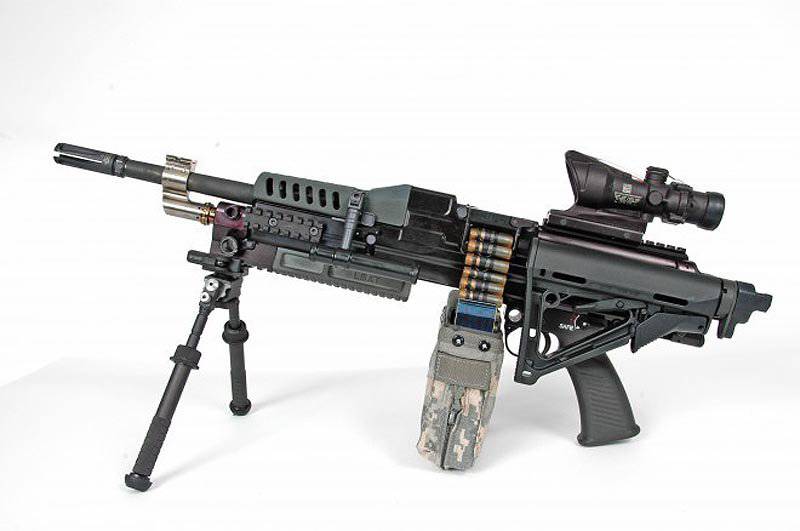
In the photo, a LSAT machine gun, clearly visible telescopic cartridges that he shoots. The LSAT team received funding to develop a caseless ammunition.
The LSAT team must also demonstrate the scalability of the telescopic cartridge technology by developing a variant of the 7,62 x 51 mm of such ammunition. "Our goal is to reduce weight by about 35%, while the volume should decrease by 10-15% compared to current cartridges," Shipley said, "at the same time, the weight reduction for weapons should be 25% compared to the light version of the current machine gun M240L or 35% if we take the standard machine gun M240B. ” This means a total weight reduction of approximately 9 kg for the shooter and 4 kg for the assistant shooter. Given the experience gained in the development of the 5,56-mm cartridge, the first shooting should begin before the end of the 2013 year. Here, too, the goal is not to develop a full-fledged weapon, but to check ballistics using test barrels. Finally, in the third part of the contract it comes to the weapon, it provides for the continued refinement of the LSAT 5,56 telescopic cartridge mm and the Light Machine Gun light machine gun. The LSAT team also took part in combat shooting conducted by the army in September 2013 of Fort Benning, known as DNNE (Dismounted Non Networked Enabled Limited Objective Experiment). LSAT was not the only technology or system tested within DNNE. This was undoubtedly one of the most innovative experiments lasting 72 hours, which began with a ghost to a normal weapons battle. Then, combat training was conducted in urban conditions at the branch level, which made it possible to evaluate the capabilities of the systems in many aspects. In addition to the obvious reduction in mass and volume, the advantages of a new weapon system include improvements in efficiency, controllability and accuracy. For this experiment, the LSAT team provided 10000 live ammunition, and also specifically designed a blank cartridge that was used in Fort Benning's 8000 pieces. “We are awaiting the results of the experiment, which should be officially published before the end of the year,” Shipley said. - These results will be used to further formulate the requirements for prospective small arms, which should be put into service in the form of individual weapons and weapons of the branch.
The US military is undoubtedly one of the largest consumers of small-caliber ammunition, given the number of personnel and the amount of combat training. The decision to develop a cartridge that has higher performance compared to the cartridge M855, was combined with the "green" task to minimize the proportion of lead. Thus, the new modified cartridge M855A1 Enhanced Performance Round (EPR) has a higher efficiency and environmental friendliness. The lead core of the 62 granule mass (4,02 grams) was replaced by copper, the steel tip took an arrow shape, and fire extinguishing agent and thinner were added to the powder. Data on increasing the initial velocity and pressure in the chamber were not presented, but it was stated that a sheet of mild steel 9,5 mm thick now breaks through with 350 meters (better than the current 7,62-mm M80 cartridge). same sheet of all with 855 meters. “Improved consistency and range of action”, - this is how the army describes the impact of a new bullet on unarmored targets. All this is due to the fact that the new cartridge M160A855 does not depend on yaw and provides the same characteristics for unarmored targets, regardless of the angle of yaw and pitch. The trajectory is identical to the trajectory of M1, which helps in adapting to new conditions of combat training.
The main partner of the army in the M855A1 EPR cartridge, ATK, has supplied over 2010 million ammunition since its launch in 921. According to the latest Picatinny Arsenal data presented in the middle of 2013, the transition to a new patron allowed to exclude about 2000 tons of lead from production wastes. The Arsenal Group for the EPR cartridge together with the ATK is currently using the same technology to refine the 7,62-mm M80 cartridge; A new lead-free cartridge M80A1 EPR along with the tracer M62A1 EPR should appear in the 2014 year. According to Arsenal Picatinny, over 3600 tons of lead can be excluded from the process from 2013 to 2018, taking into account the estimated volume of purchases of munitions M855A1 and M80A1.
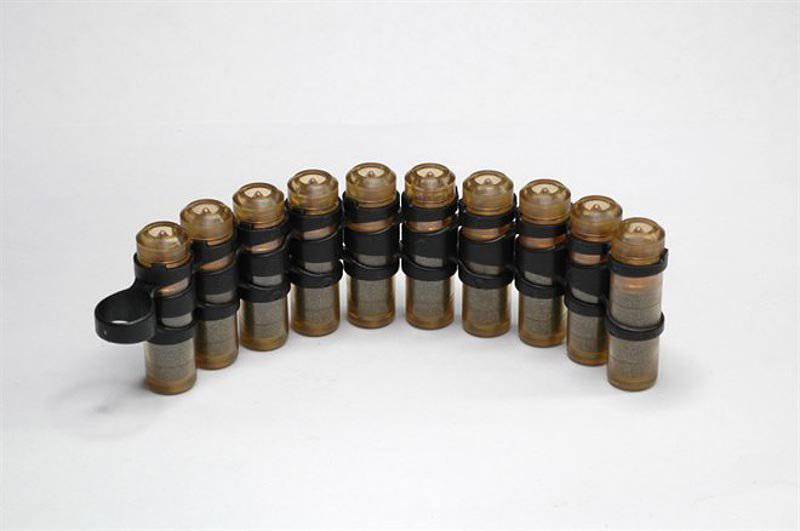
The configuration of the 5,56-mm telescopic cartridge is clearly visible in the near view. A new phase of R & D will lead to the development of the 7,62-mm telescopic cartridge
In 2012, Israel Military Industries introduced the thin-walled 5,56 x 45 mm chuck, which provides extremely high precision. The company claims that dispersion is halved compared to standard ammunition. The 42 granular bullet (2,72 gram) is made of sintered copper and tin powder, which makes it ideal not only for combat training, but also for use in confined spaces where the risk of rebound is usually high.
Another new cartridge was developed, which was introduced in the middle of 2013. It is based on a 54 granular pool (3,37 grams) with a stronger core, which allowed for a significant improvement in performance compared to a standard cartridge. It is capable of penetrating steel with a thickness of more than 5 mm and can compete with 7,62-mm ammunition in accuracy, ensuring the accuracy of 8 cm at a distance of 100 meters. Its initial speed reaches 970 m / s when using the 20-inch barrel. IMI does not disclose details, but it is clear that its goals were similar to those of overseas colleagues who developed the M855A1 cartridge. According to IMI, the cost of a new cartridge will be much closer to the cost of a standard 5,56-mm cartridge than to the cost of armor-piercing cartridges (the price is predicted to be 20-30% higher compared to a conventional cartridge). The company does not want to stop there and intends to enter the market with 2014 x 7,62 mm and 51 x 12,7 mm cartridges with a solid core in the 99 year, although at the same time thin-walled versions for these calibers are not expected. Another new member in the IMI 5,56 family of ammunition is the 77 Grand Prix cartridge (5 grams) version, with an initial speed of 835 m / s, ensuring accuracy of 50 cm at a distance of 550 meters.
Nammo was the first company to develop a complete family of harmless or non-toxic 5,56 mm, 7,62 mm and 9 mm small-caliber ammunition that fully comply with the NATO Stanag standard. Since 1999, the company has supplied over 400 with millions of cartridges, freeing “Mother Nature” from more than 1800 tons of lead. In 5,56 mm and 7,62 mm ammunition, lead was replaced with a clad shell surrounding the steel core and the steel piercer. Lead-free primers helped turn it into a truly lead-free cartridge.
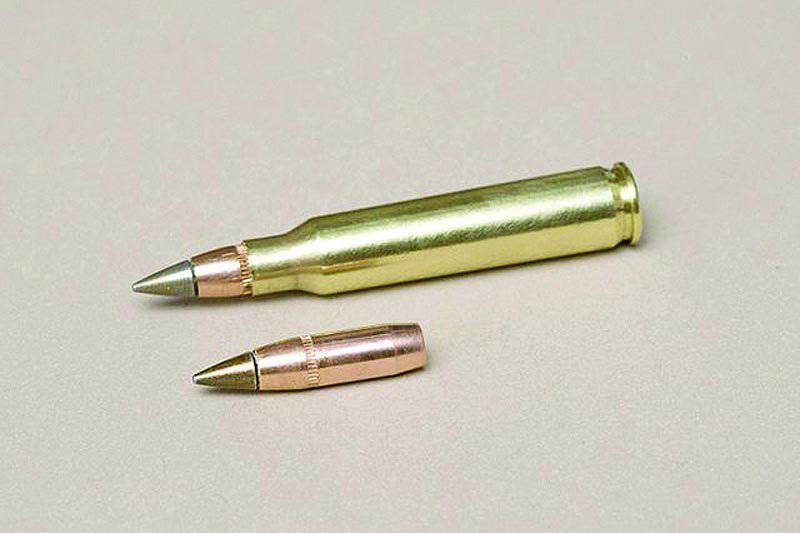
Production of the improved ATK cartridge M855A1 Enhanced Performance Round reaches a mark of one billion pieces. The harmful effect of the new cartridge on the environment is close to zero.

Nammo has developed a second-generation “green” 5,56-mm cartridge known as the 5,56 x 45 BNT 4 HP Mk2, where HP means high performance (read better efficiency and accuracy)
In order to increase accuracy and impact on the target and at the same time reduce barrel erosion and gas emissions, Nammo decided to develop a version of the Mk2009 2-mm lead-free cartridge in the middle of 5,56. At the design stage, Nammo considered numerous alternatives, since three different powders were evaluated (two with spherical grains and one extruded) and four different non-toxic capsules with different mixtures, while nine different bullets with different surface coatings and geometric shapes were created. The new cartridge 5,56 x 45 mm was qualified by the Norwegian army in 2011 year and received the designation BNT 4 HP Mk2 (Ball Non Toxic 4 High Performance - bullet non-toxic 4 with high performance). Norway is currently in the process of obtaining a full NATO qualification for this cartridge, which is expected in 2014. Nammo claims that it offers increased mortality, retains excellent armor-piercing characteristics and does not form debris for unarmored purposes. The increased armor penetration of the Mk2 (NATO 3,5-mm steel sheet from a distance of more than 700 meters) is inherent not only in the steel core, but also in low-resistance construction, which allows for a greater amount of kinetic energy to be delivered to the target. Its 4 bullet grams has an initial speed of 930 m / s and a standard deviation of less than 25 mm. For poorly defended purposes, the bullet of a new patron starts earlier. For example, the Mk2 begins to deviate in 70 mm from the entry point to the gelatin block, whereas the former version of the Mk1 begins to "tumble" in 150 mm, and the SS109 version in 125 mm. The company won a long-term contract for the supply of this patron of the Norwegian army, the first deliveries took place at the beginning of 2012.

The photo clearly shows one of the vertical grooves (or grooves) in the Nammo 7,62 x 51 BNT 6 RR. They increase frontal resistance and reduce axial rotation, ultimately causing “tumbling” of the bullet.
On the other hand, the Nammo 7,62 x 51 mm BNT 9 HP chuck features are far ahead of the standard M80 chuck, and so it is still considered quite satisfactory. This does not mean, however, that this Scandinavian country has nothing new in its 7,62 mm cartridges portfolio. With experience gained several years ago in developing the larger 12,7 x 99 mm RR (Reduced Range) caliber family, which included a sports shooting cartridge for cartridge tape, regular and tracer, Nammo developed the 7,62 x 51 BNT 6 RR in order to reduce the danger zone during combat training and actions in urban combat, since the cartridge is fully suitable for use in combat operations at 200 meters. The problem is that the standard 7,62-mm bullet can fly to 4000 meters, keeping almost the same amount of energy throughout its path. Therefore, in an effort to solve this problem, Nammo developed a family of 7,62 x 51 mm RR lead free ammunition with full combat characteristics and trajectory comparable to M80 up to at least 200 meters, but which fly only 1500 meters. This was achieved by grooves (or grooves) along the 6,2-gram (96 gran) bullets that reduce drag, but more importantly reduce the speed of rotation and cause "tumbling" after 200 meters. The cartridge passed all qualification tests and was presented to potential customers at the end of 2013. Two more 7,62 x 51 mm RR cartridges (tracer and low tracer) are being developed, the development of which can be completed by the middle of the 2014 year. Then it will be possible to talk about the supply of tactical sets of cartridges RR with different configurations of cartridge tapes, including conventional cartridges, tracer or weakly tracing ammunition. Nammo was thinking about a similar solution for 5,56 x 45 mm cartridges, but apparently this is not currently a priority for customers.
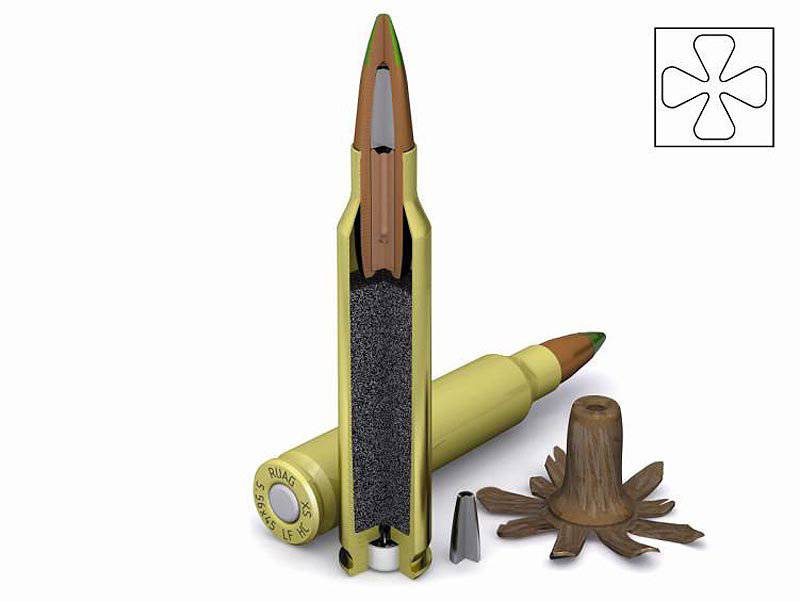
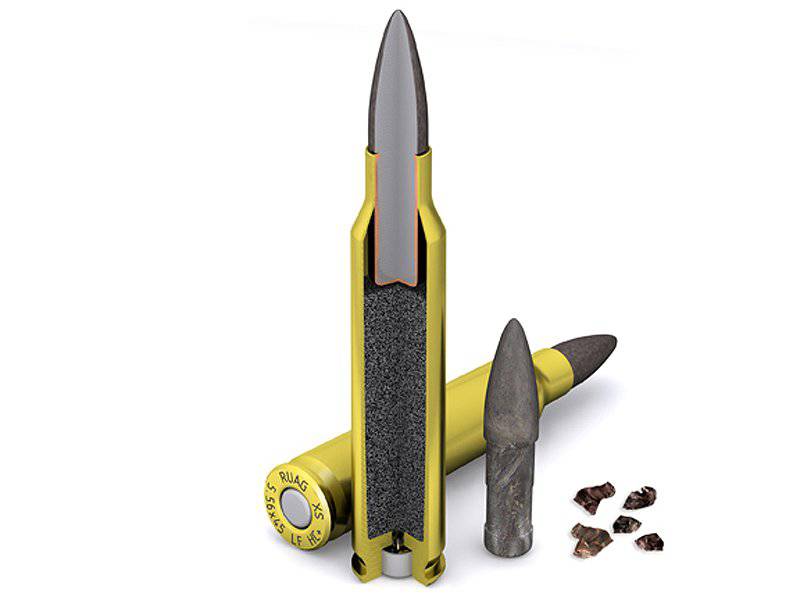
Developed according to the French tender, the Ruag Ammotec 5,56 x 45 mm LF HC + SX Horizon cartridge now attracts the interest of many countries because it provides characteristics close to armor piercing at a low cost.
Ruag Ammotec 5.56 mm x 45 LF HC SX received full NATO certification in May 2013; in addition, lead-free cartridges of larger calibers are available.
Ruag Ammotec's 5,56 x 45 mm LF HC + SX Horizon cartridge was developed as a result of France’s interest in the 5,56 x 45 mm machine-gun cartridge with improved armor-piercing characteristics, but at a price lower than full-armor-piercing cartridges. It has been on the market for almost two years and is currently showing interest in several Middle Eastern countries. Its 62 granular bullet is made of hardened steel core, capable of penetrating steel 7 mm thick with HB 350 hardness from 350 meters, while a brass belt that makes up to one third of the mass of the bullet provides optimal torsion and maximum accuracy. The cartridge uses Sintox ignition technology, which makes it a de facto lead-free cartridge.
Eco-friendly cartridges are becoming a standard product in a company from the Swiss city of Thun. In May 2013, the company received a full NATO certificate for its 5,56 x 45 mm LF HC SX cartridge. This is a completely lead free ammunition that can go either with the SS-109 bullet or the M-855. The qualification tests were conducted in the UK and at the NATO Regional Test Center in Pendin. Fully lead-free cartridge LF HC SX certified in the armed forces of Luxembourg; it is distinguished by heavy non-metallic primers, lead-free bullet and optimized powder compositions that do not form harmful emissions. Ruag Ammotec has extended its lead-free technology to larger calibers and is currently offering a 7,62-tracer cartridge and an 12,7 x 99-mm armor-piercing incendiary cartridge. The Swiss ammunition manufacturer also offers two 12,7 x 99 mm caliber cartridges, the use of which simplifies the combat training process. They come in two versions: Short Range Solid (one-piece short-range) and Short Range Solid Tracer (one-piece short-range tracer), respectively with gran 698 bullets (45,23 grams) and 664 grana (43 grams). The all-metal copper-zinc bullet is specially designed with a large frontal resistance and does not have a plastic tip, which guarantees safe use in helicopters, where the tips can be dropped into the engine. The Short Range Solid family has a range of real fire up to 800 meters and allows you to significantly reduce the danger zone range, which for conventional ammunition is about 7 km, and for the Ammotec SR Solid family it is half the size. The SR Solid family will be available on the market in 2014.
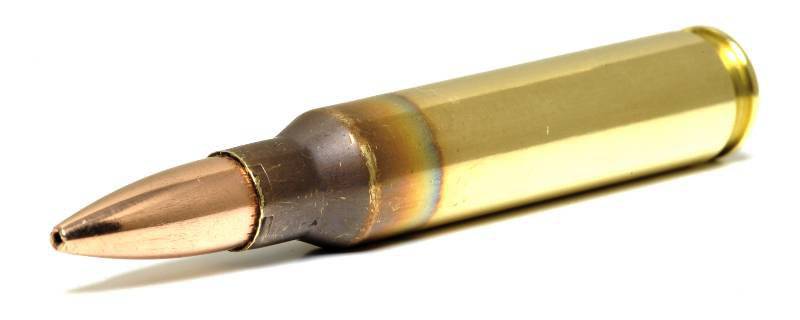
In January, 2014, Israel Military Industry's Yitzhak Division, specializing in small-caliber ammunition, announced that the new 5,56-mm cartridge 77 gran, which has the best accuracy and stopping power up to 600 meters, was named Razor Core and was tested in combat conditions at an unnamed customer
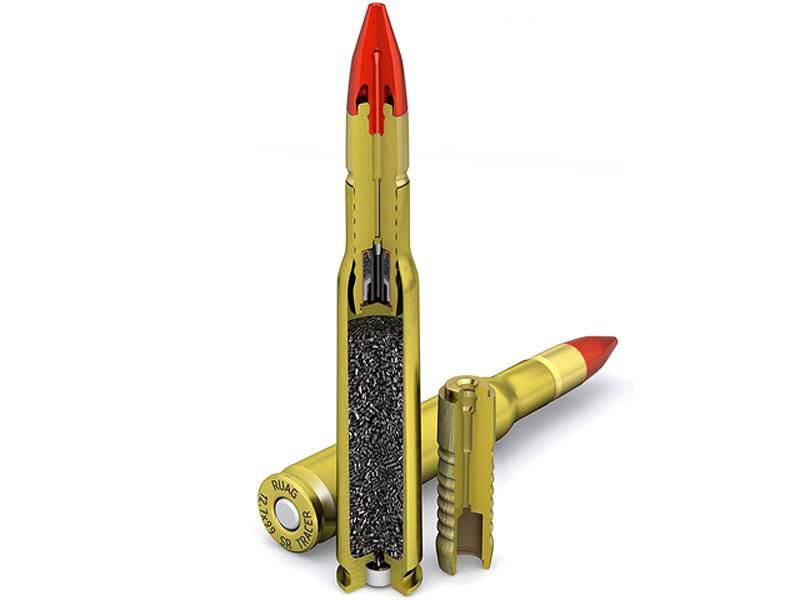
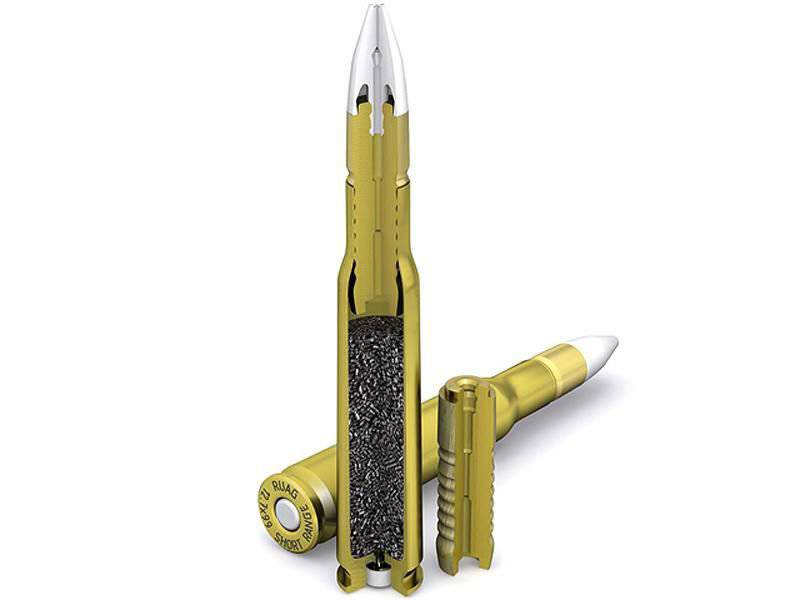
In order to significantly increase the safe area when using 12,7 x 99 mm Short Range cartridges, Ruag Ammotec has developed an aerodynamic shape that significantly increases the drag of gauges.
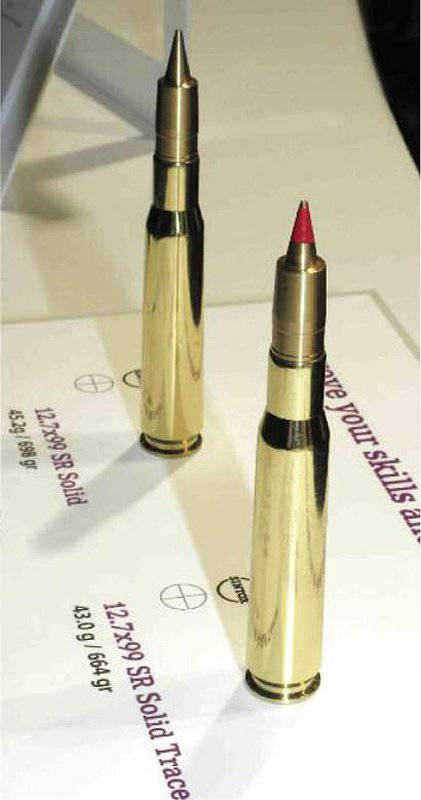
Two members of the Ruag Ammotec Solid family of 12,7 mm caliber with reduced range: a tracer and a standard cartridge (in the background) of calibers
Metallwerk Elisenhutte GmbH (better known as MEN) has also developed an 5,56 x 45 mm cartridge specifically for operations in crowded places. The 56 Gran Bullet (3,63 Gram), known as the Low Penetration Bullet (low penetration bullet), has a tungsten powder core that guarantees a very large amount of energy to be transmitted and a low prohibitive effect (when tested on gelatin, the bullet showed penetration around 20 cm ). A cartridge with an initial speed of 1025 m / s and accuracy of less than 1 minutes of angle is mainly intended for snipers. MEN has developed an 7,62 x 51 mm cartridge with a high penetration ability HPC (High Performance Core), which is capable of hitting a NATO steel plate at 1100 meters. His bullet is made of hardened steel with a small amount of lead in the back to increase the mass to the 150 gran, which almost corresponds to the mass of the DM151 armor-piercing cartridge in the 151 gran. The use of hardened steel instead of tungsten carbide (used in armor-piercing cartridge) gives a slight decrease in armor-piercing characteristics, two bullets have the same initial velocity 827 m / s. But, apparently, there is no intention to apply these innovations in the caliber 5,56 mm. However, at a cost HPC costs between the standard DM41 cartridge and the DM151 AP armor-piercing, but a little closer to the latter.
Materials used:
www.ruag.com
www.nammo.com
www.imi-israel.com
www.textronsystems.com
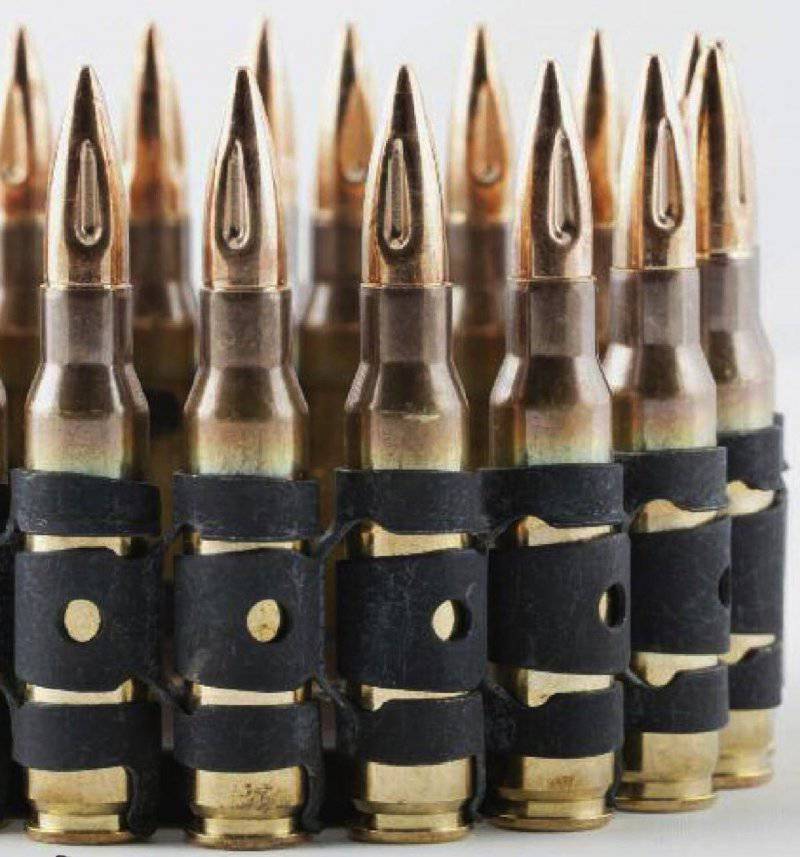
Information